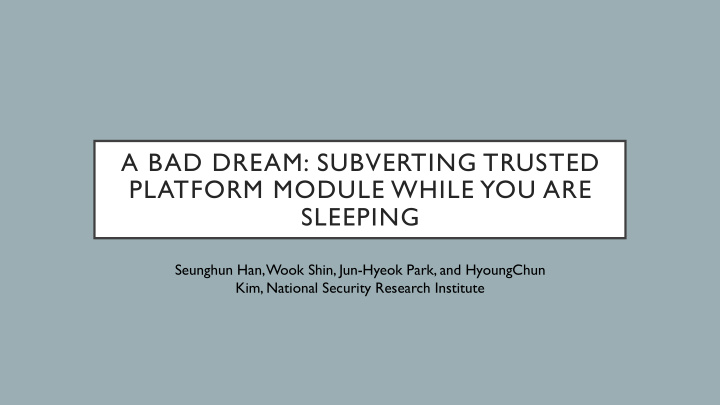



A BAD DREAM: SUBVERTING TRUSTED PLATFORM MODULE WHILE YOU ARE SLEEPING Seunghun Han, Wook Shin, Jun-Hyeok Park, and HyoungChun Kim, National Security Research Institute
BACKGROUND • Trusted Computing Group (TCG) • Trusted Platform Module (TPM) is the core technology that provides an anchor of trust • Standardize the TPM Technology • Security related function • APIs • Protocols 2
BACKGROUND - TPM • TPM is a tamper resistant device that stores RSA encryption keys associated to the system for hardware authentication • Ensure integrity of a platform (server, laptop, tablet, etc.) • Contains several Platform Configuration Registers (PCRs) that allow secure storage and security metrics • Metrics used to detect changes to previous configurations • Use Case: Cryptographically record (measure) software state 3
BACKGROUND - TPM • Used to determine credibility of system by checking the values stored in PCRs • Access control with secret data • Seal – an operation to encrypt data using PCRs • Sealed data can only be decrypted by the TPM when the PCR values match specified values 4
BACKGROUND – RTM • Root of Trust for Measurement • Initiating measurement is done by a trusted software component called the core RTM (CRTM) • Stored in ROM to protect against attacks • First set of instructions when chain of trust is established • Trust Anchor • Trust is assumed and not derived • Trustworthiness of whole chain depends on this element 5
BACKGROUND – RTM • SRTM is the trust anchor initialized by static CRTM when the host platform starts a power-on or restart • DRTM is started by dynamic CRTM and launches a measured environment at runtime without platform reset 6
7
BACKGROUND – ACPI • Advanced Configuration and Power Interface • Global Power States • Working (G0 or S0) • Sleeping (G1) • Soft-off (G2) • Mechanical off (G3) 8
BACKGROUND – ACPI • Sleeping States • S1 – Power on Suspend • CPU stops executing instructions (all devices like CPU and RAM are powered) • S2 – CPU is powered off • S3 – Sleep – All devices powered off except for RAM • S4 – Hibernation – All devices powered off • Platform context in RAM is saved to disk 9
ASSUMPTIONS • System measures the boot components using TCG’s SRTM and DRTM • The stored measurements in TPM are verified by a remote verifier • When modifications are made to the components they are detected 10
THREAT MODEL • Consider an attacker who has already acquired the Ring-0 privilege • Has admin access to: • Firmware • Bootloader • Kernel • Applications • He or she cannot flash the firmware with arbitrary code • Cannot rollback to an old version of the firmware, where the attacker can exploit a known vulnerability. 11
ACPI SLEEP PROCESS WITH TPM 12
WHAT IF OS IS COMPROMISED AND DOESN’T NOTIFY THE TPM OF SLEEP? 13
WHAT IF MALWARE INTERCEPTS THE COUNTERFLOW BETWEEN ACPI AND OS? 14
15
EVALUATION 16
PCR VALUES 17
COUNTERMEASURES • Grey Area Vulnerability • Disable S3 sleeping state in BIOS • Revise TPM 2.0 to enter failure mode if there is no state to restore • Lost Pointer Vulnerability • Update tboot • Apply researchers patch to tboot 18
CONCLUSION • Two vulnerabilities found to undermine TPM with the S3 sleeping state • Flaw with TPM 2.0 specification • Flaw in implementation flow of tboot • Flaw in open source implementation of Intel TXT 19
Recommend
More recommend